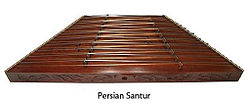Santoor (Persian instrument)
 |
|
| String | |
|---|---|
| Classification | Stringed, Struck |
| Playing range | |
| Related instruments | |
| Hammered Dulcimer | |
The santur (also santūr, santour, santoor) (Persian: سنتور) is a hammered dulcimer of Iranian origin. The term Santur originated with meaning "100 strings."
The oval-shaped Mezrabs (mallets) are feather-weight and are held between the thumb, index and middle fingers. A typical Persian santur has two sets of bridges, providing a range of approximately three octaves. The right-hand strings are made of brass or copper, while the left-hand strings are made of steel. Two rows of 9 bridges. A total of 18 bridges divide the santur into three positions. Over each bridge crosses four strings tuned in unison, spanning horizontally across the right and left side of the instrument. There are three sections of nine pitches: each for the bass, middle and higher octave called behind the left bridges comprising 27 notes all together. The top "F" note is repeated 2 times, creating a total of 25 separate tones in the Santur. The Persian santur is primarily tuned to a variety of different diatonic scales utilizing 1/4 tones which are designated into 12 modes (Dastgahs) of Persian classical music. These 12 Dastgahs are the repertory of Persian classical music known as the Radif. They also had 16 inch botos.
Similar musical instruments have been present since medieval times all over the world, including Armenia, China, Greece, India, etc. The Indian santoor is wider, more rectangular and has more strings. Its corresponding mallets are also held differently played with a different technique. The eastern European version of the santur called the cimbalom, which is much larger and chromatic, is used to accompany Romani music.
Iran
Greece
(Greek Santouri)
India (see Indian santour)
Iraq
Japan
Germany
Versions of the santur or hammered dulcimer are used throughout the world. In Eastern Europe, a larger descendant of the hammered dulcimer called the cimbalom is played and has been used by a number of classical composers, including Zoltán Kodály, Igor Stravinsky and Pierre Boulez, and more recently, in a different musical context, by Blue Man Group. The khim is the name of both the Thai and the Khmer hammered dulcimer. The Chinese yangqin is a type of hammered dulcimer that originated in Persia. The santur and santoor are found in the Middle East and India, respectively.
...
Wikipedia

